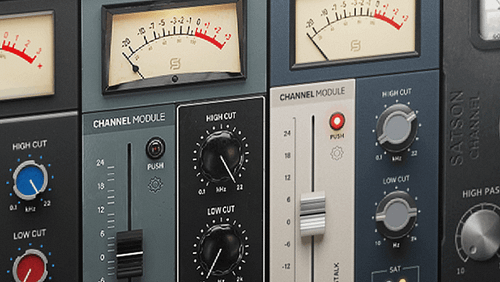Analogue mixing consoles are magical pieces of gear. They instantly transport us into the recording studio mood and get musicians excited about tracking and playing their music through them. In fact, some are responsible for the sound of the most iconic songs and albums in music history. Part of it comes from their subtle harmonic distortion and analog summing which add punch, presence, and color to the audio.
Nowadays, modern digital technology and analog modeling techniques have brought the sound from these large-format consoles straight into our computers, allowing engineers and producers to get the cohesion and three-dimensionality only obtained when mixing in big studios.
Let’s break down some of the benefits of adding analog console emulation plug-ins into your workflow.
1- Virtual console
We have talked about creating virtual studios in previous articles. This process consists of the creation of a session template in your DAW with the most common plug-ins, tracks, and routing that will be used in your sessions.
By adding console emulation plug-ins on every track and summing buses in this virtual studio you can mimic not only the sound but also the workflow of a real analog console. This will add non-linearities, saturation, and a common texture to your mixes right from the start. Just like it would when working in a real console.
2- Metering
Track’s meters in most DAWs are defaulted to dBFS. This could be misleading for less experienced engineers aiming to record the signals as hot as possible without peaking in digital. Although not incorrect this can cause problems and hiccups down the line when mixing. Why not use the VU meters provided in console emulations instead?
These types of meters provide a reading of the perceived loudness of the audio signal and are super helpful to get that sweet spot in our levels that will allow us to balance our tracks quicker and get more solid mixes.
3- Saturation
The addition of harmonic distortion is one of the “side effects” of using analog equipment. This results in fuller and warmer sounds that are pleasant to the ears.
When digital recording started it resulted in cleaner sounding mixes which felt a bit lifeless, causing the engineers to add saturation to different degrees afterward to achieve the density that they were missing.
Console emulation plug-ins help to recover part of that missing saturation and even create more textures and enhancements in the sound beyond the scope of a real console. Combine and daisy chain consoles in your inserts to sum the subtle saturation of the plug-ins, use gain compensation features to achieve greater distortion, or get different tones and colors in your summing busses by changing the model of the console. The possibilities are endless thanks to the flexibility of modern DAWs.
Sonimus Palette
Within Sonimus products, you can find different options to increase your console emulation color palette. plug-ins like Satson, Britson, and Satson CS can elevate and enhance any aseptic mix.
Both Britson and Satson provide the same features of gain staging, saturation, gain compensation, metering, and even grouping capabilities, but with two completely different flavours of sound. Plus the easy-to-use filtering section of the plug-ins helps to quickly shape the sound of your tracks. You can check this video from Paul Third comparing the two to get a feeling of what they get to offer.
On the other hand, Satson CS offers the sound of a console with all the benefits from a channel strip. You don’t get the Bus component from Britson or Satson, but the modularity and preset saving capabilities of the plug-in allow users to create custom setups for each channel, either tracks or busses.
Do you use console emulation plug-ins in your sessions? Which one is your favourite? Let us know in the comments below and share with us some of your favourite ways of working with this type of plug-in.








Leave A Comment
You must be logged in to post a comment.